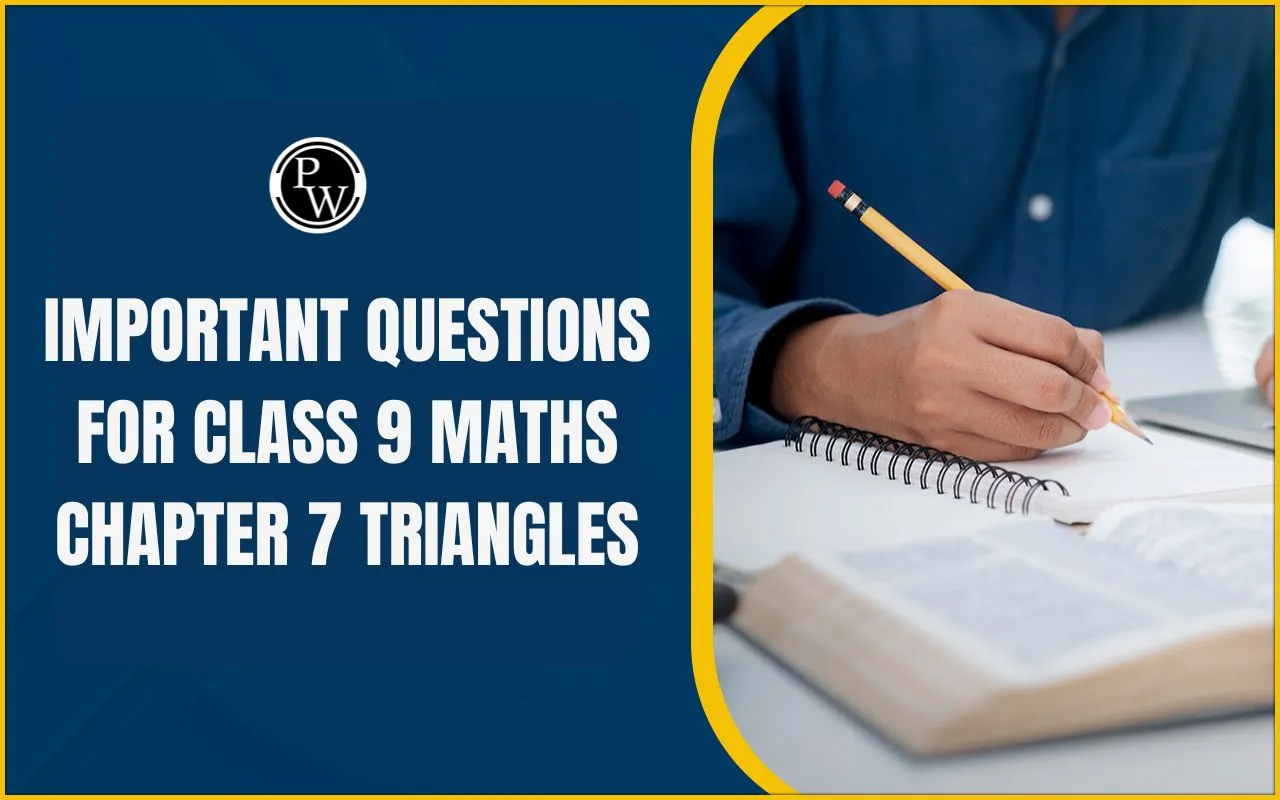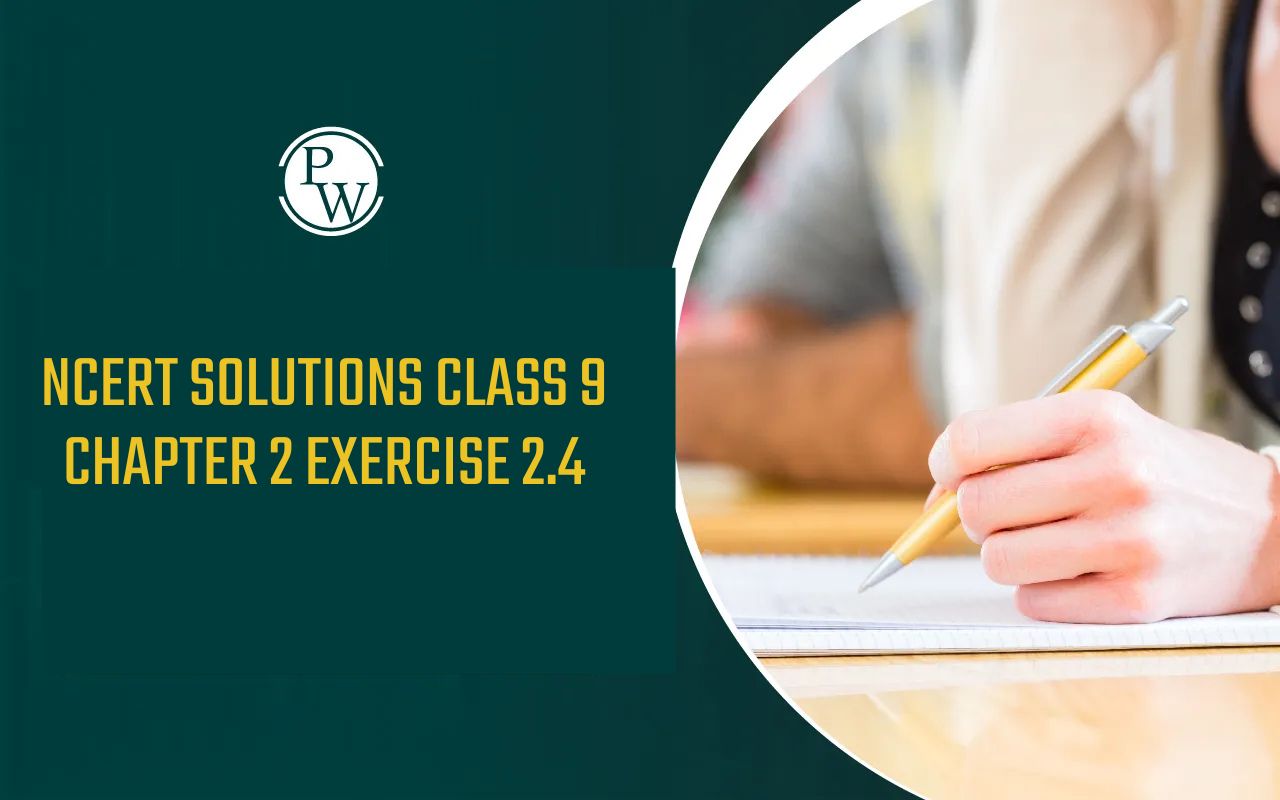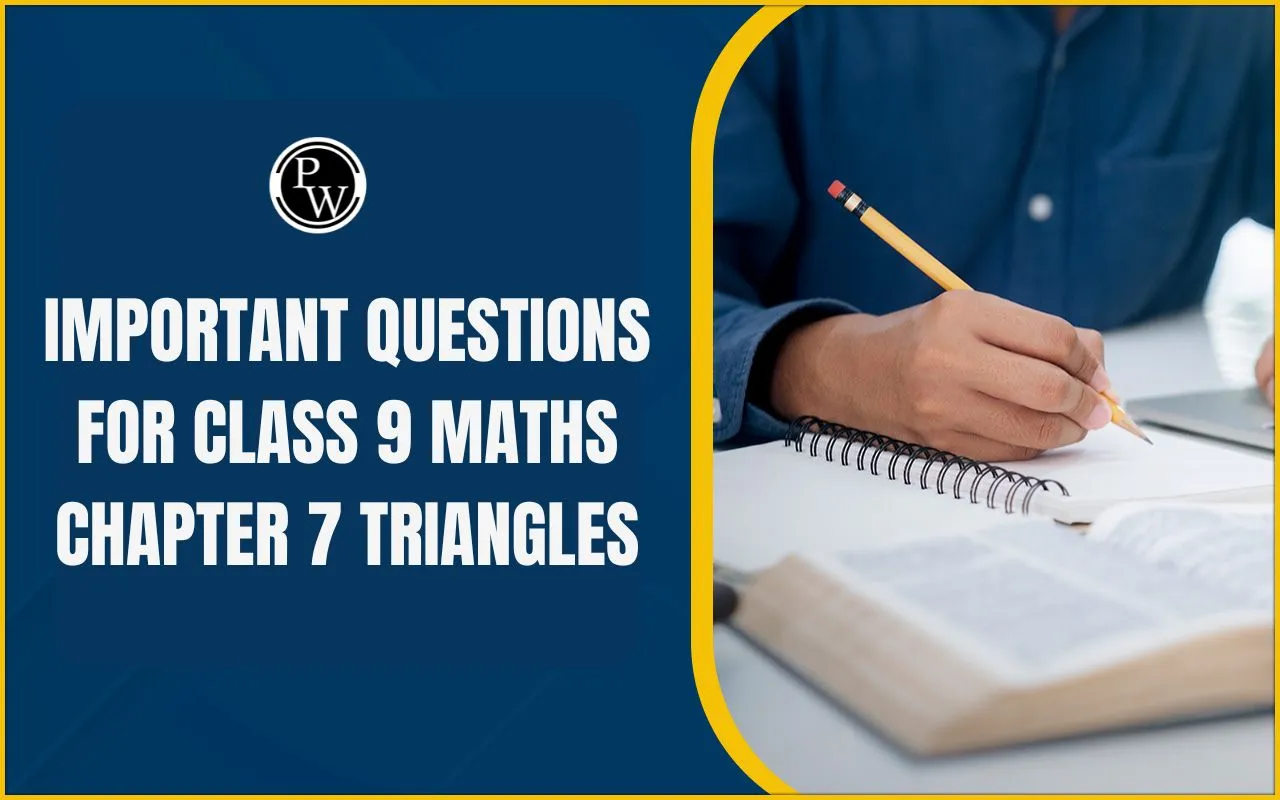

Important Questions for Class 9 Maths Chapter 7 help students focus on the key topics of the class 9 marhs syllabus like Triangles, Pythagoras Theorem, Congruence, and Similarity. Practicing these questions improves understanding and problem-solving skills.
Students can refer to Class 9 Maths Chapter 7 Extra Questions to get more practice and strengthen their concepts. These questions are designed to cover all important areas of the chapter and help in exam preparation effectively.
CBSE Class 9 Sample Papers Maths 2025-26
Important Questions for Class 9 Maths Chapter 7 Overview
CBSE CBSE Class 9 Maths Chapter 7 is an important chapter for students, and practicing the right questions can help you score better. Here, we have compiled the Class 9 Maths Chapter 7 Important Questions that cover all key concepts and types of problems.
These important questions of Chapter 7 Maths Class 9 are selected to help you understand the chapter clearly and prepare effectively for exams. By going through these questions students can strengthen their skills and improve their problem-solving abilities.
Important questions for class 9 maths chapter 7 with Answers
Below are the answers to help students practice effectively. These important questions on triangles class 9 cover all the essential problems from Chapter 7 making it easier to understand concepts and solve different types of questions.
By solving these solutions students can strengthen their understanding of triangles and improve their exam preparation.
Class 7 Maths Chapter 9 1 Mark Questions
Below are the one-mark questions and their solutions from Class 7 Maths Chapter 9. These questions help students practice quickly, revise key concepts, and prepare effectively for exams. By going through these questions, students can strengthen their understanding of the chapter and improve their problem-solving speed.
1. A closed figure formed by joining the three non
collinear points and that has two equal sides in length is:
(A) Scalene triangle
(B) Isosceles triangle
(C) Triangle
(D) None of these
Ans. (B)
2. In triangle ABC, if AB=BC and ∠B = 70°, ∠A will be:
Ans. (C)
Sol. Given,
AB = BC
Hence, ∠A=∠C
And ∠B = 70°
By angle sum property of triangle we know:
∠A+∠B+∠C = 180°
2∠A+∠B=180°
2∠A = 180-∠B = 180-70 = 110°
∠A = 55°
3. In triangles ABC and PQR, AB = AC, ∠C = ∠P and ∠B = ∠Q. The two triangles are
(A) Isosceles and congruent
(B) Isosceles but not congruent
(C) Congruent but not isosceles
(D) Neither congruent nor isosceles
Ans. (B)
Sol. Consider two triangles, ABC and PQR. If the sides
AB = AC and ∠C = ∠P and ∠B = ∠Q, then the two triangles are said to be isosceles, but they are not congruent
4. In triangles ABC and DEF, AB = FD and ∠A = ∠D. The two triangles will be congruent by SAS axiom if:
(A) BC = EF
(B) AC = DE
(C) AC = EF
(D) BC = DE
Ans. (B)
5. In two triangles, ABC and PQR, ∠A = 30°, ∠B = 70°, ∠P = 70°, ∠Q = 80° and AB = RP, then
(A) ΔABC ≌ ΔPQR
(B) ΔABC ≌ ΔQRP
(C) ΔABC ≌ ΔRPQ
(D) ΔABC ≌ ΔRQP
Ans. (C)
Sol. In ABC, A = 30°, B = 70°
C = 180° – (A + B)
[Angle sum property of triangle]
C = 180° – (30° + 70°)
C = 80°
In PQR , P = 70°, Q = 80°
So, R = 180° – (P + Q)
[Angle sum property of triangle]
R = 180° – (70° + 80°)
R = 30°
In the ABC and PQR, we have
C = Q
A = R
AB = PR [Given]
ABC RPQ
[By ASA congruence]
Class 7 Maths Chapter 9 2 Mark Questions
Below are the important 2-mark questions from Class 7 Maths Chapter 9. These questions focus on key concepts and help students practice effectively. Solving these questions improves understanding of the chapter and prepares students well for exams.
6. ABC is a right-angled triangle in which∠A = 90°and AB AC. Find ∠B and ∠C.
Sol.
In the question, it is given that
∠A = 90° and AB = AC
AB = AC
⇒ ∠B = ∠C (They are angles opposite to the
equal sides and so, they are equal)
Now,
∠A+∠B+∠C = 180° (Since the sum of the interior
angles of the triangle)
∴ 90° + 2∠B = 180°
⇒ 2∠B = 90°
⇒ ∠B = 45°
So, ∠B = ∠C = 45°
7. Show that the angles of an equilateral triangle are 60° each.
Sol. Let ABC be an equilateral triangle as shown
Below:
Here, BC = AC = AB (Since the length of all sides
is same)
⇒ ∠A = ∠B =∠C (Sides opposite to the equal
angles are equal.)
Also, we know that
∠A+∠B+∠C = 180°
⇒ 3∠A = 180°
⇒ ∠A = 60°
∴ ∠A = ∠B = ∠C = 60°
So, the angles of an equilateral triangle are always
60° each.
Sol. In the given ABC, A = 100°, AD bisects A and AD ⊥BC.
Here, we need to find B.
As, AD bisects A
We get,
BAD = DAC
100° = 2BAD
BAD = 50°
Now, according to angle sum property of the
triangle in ABD
A + B + D = 180°
50° + B + 90° = 180°
140° + B = 180°
B = 180° – 140°
= 40°
9. In Δ PQR, ∠R = ∠P and QR = 4 cm and PR = 5 cm. Then find the length of PQ.
Sol. ΔPQR, ∠R = ∠P and QR = 4 cm and PR = 5 cm
Since, ∠R = ∠P
ΔPQR is an isosceles triangle.
Hence, PQ = QR
⇒ PQ = 4cm
10. In the given figure, ∠x and ∠y are:
Sol.
The figure has two equal adjacent sides.
So, the figure is a kite.
The diagonals of the kite bisect the angles of the
kite.
Since AD is diagonal, it bisects the angles BDC
and BAC.
Find the value of x:
CAD = BDA
x = 37°
Find the value of Y:
CDA = BDA
y = 70°
Vale of angle x and angle y are 37° and 70°
respectively
11. AB is a line segment and line l is its perpendicular bisector. Show that every point on line l is equidistant from A and B.
Sol. In the following figure, AB is the given line
segment and l is its perpendicular bisector.
P is any point on the given line l.
Now, in AOP and BOP
AO = BO
AOP = BOP = 90° (l Perpendicular bisector
of AB
OP = OP(Common)
AOP BOP
AP = BP (By c.p.c.t)
Hence, every point on line l is equidistant from
A and B.
Class 7 Maths Chapter 3 Marks Questions
Below are the important 3-mark questions from Class 7 Maths Chapter 9. These questions cover key concepts and help students practice effectively. Solving them improves understanding, boosts problem-solving skills, and prepares students well for exams.
13. ABC is an isosceles triangle with AB = AC show that ∠B = ∠C.
Sol. Draw AP⊥BC
In the question, it is given that AB = AC
Now, ΔABP and ΔACP are congruent by RHS
congruency as
∠APB = ∠APC = 90° (AP is altitude)
AB = AC (Given in the question)
AP = AP (Common side)
So, ΔABP ≅ ΔACP. (By RHS)
∴ ∠B = ∠C (by CPCT)
14. ABCD is a quadrilateral in which AD = BC and ∠ DAB = ∠CBA (see Figure).
Prove that
(i) ΔABD ≅ ΔBAC
(ii) BD = AC
(iii) ∠ABD = ∠BAC.
Sol. The given parameters from the questions are
∠DAB = ∠CBA and AD = BC.
(i) ΔABD and ΔBAC are congruent by SAS
congruency as
AB = BA (common arm)
∠DAB = ∠CBA and AD = BC (given)
So, triangles ABD and BAC are similar i.e.
ΔABD ≅ ΔBAC. (Hence proved).
(ii) It is now known that ΔABD ≅ ΔBAC so,
BD = AC (by the rule of CPCT).
(iii) Since ΔABD ≅ ΔBAC so,
Angles ∠ABD = ∠BAC (by the rule of
CPCT).
15. AD and BC are equal perpendiculars to a line segment AB (see Figure). Show that CD bisects AB.
Sol. It is given that AD and BC are two equal
perpendiculars to AB.
We will have to prove that CD is the bisector of
AB
Now,
Triangles ΔAOD and ΔBOC are congruent by
AAS congruency since:
(i) ∠A = ∠B (Each 90°)
(ii) AD = BC (As given in the question)
(iii) ∠AOD = ∠BOC (Vertically opposite angles)
∴ ΔAOD ≅ ΔBOC.
So, AO = OB (by the rule of CPCT).
Thus, CD bisects AB (Hence proved).
16. In Figure, AC = AE, AB = AD and ∠BAD =
∠ EAC. Show that BC = DE.
Sol. It is given in the question that AB = AD,
AC = AE, and ∠BAD = ∠EAC
To prove:
The line segment BC and DE are congruent i.e.
BC = DE
Proof:
We know that ∠BAD = ∠EAC
Now, by adding ∠DAC on both sides we get,
∠BAD + ∠DAC = ∠EAC +∠DAC
This implies, ∠BAC = ∠EAD
Now, ΔABC and ΔADE are similar by SAS
congruency since:
(i) AC = AE (As given in the question)
(ii) ∠BAC = ∠EAD
(iii) AB = AD (It is also given in the question)
∴ Triangles ABC and ADE are congruent i.e.
ΔABC ≅ ΔADE.
So, by the rule of CPCT, it can be said that
BC = DE.
17. ABC is an isosceles triangle in which altitudes BE and CF are drawn to equal sides AC and AB respectively (see Figure). Show that these altitudes are equal.
Sol. Given:
(i) BE and CF are altitudes.
(ii) AC = AB
To prove:
BE = CF
Proof:
In triangles ΔAEB and ΔAFC
∠A = ∠A (common arm)
∠AEB = ∠AFC (right angles)
AB = AC (Given)
∴ ΔAEB ≅ ΔAFC (By AAS),
BE = CF (by CPCT).
18. ABC is a triangle in which altitudes BE and CF to sides AC and AB are equal (see Figure).
Show that
(i) ΔABE ≅ ΔACF
(ii) AB = AC, i.e., ABC is an isosceles triangle.
Sol. It is given that BE = CF
(i) In ΔABE and ΔACF,
∠A = ∠A (It is the common angle)
∠AEB = ∠AFC (They are right angles)
BE = CF (Given in the question)
∴ ΔABE ≅ ΔACF by AAS congruency condition.
(ii) AB = AC by CPCT and so, ABC is an isosceles triangle.
19. P is a point equidistant from two lines l and m intersecting at point A (see Figure). Show that the line AP bisects the angle between them
Sol. Given that lines l and m intersect each other at A.
Let PB ⊥ l, PC ⊥ m. It is given that PB = PC. You
are to show that ∠ PAB = ∠ PAC.
Let us consider ∆ PAB and ∆ PAC.
In these two triangles,
PB = PC (Given)
∠ PBA = ∠ PCA = 90° (Given)
PA = PA (Common)
So, ∆ PAB ≅ ∆ PAC (RHS rule)
So, ∠ PAB = ∠ PAC (CPCT)
20. △ABC is an isosceles triangle in which AB = AC. Side BA is produced to D such that AD = AB (see figure ). Show that ∠BCD is a right angle. Given: △ABC is an isosceles triangle in AB = AC. Side BA is produced to D such that AD = AB
Sol. To Prove: ∠BCD is a right angle.
Proof : ABC is an isosceles triangle
∠ABC=∠ACB …(1)
∵ AB=AC and AD=AB
∴ AC=AD
∴ In △ACD
∠CDA=∠ACD
(Angles opposite to equal sides of a triangle are
equal)
⇒ ∠CDB=∠ACD …(2)
Adding the corresponding sides of (1) and (2), we
get
∠ABC+∠CDB=∠ACB+∠ACD
⇒ ∠ABC+∠CDB=∠BCD …(3)
In △BCD
∠BCD+∠DBC+∠CDB=180
(∵ Sum of all the angles of a triangle is 180°)
⇒ ∠BCD + ∠BCD =180° [Using (3)]
2∠BCD = 180°
⇒ ∠BCD = 90°
⇒ ∠BCD is a right angle.
Class 7 Maths Chapter 9 5 Mark Questions
Below are the important 5-mark questions from Class 7 Maths Chapter 9. These questions cover the most important concepts and help students practice effectively. Solving them improves understanding, enhances problem-solving skills, and prepares students thoroughly for exams.
21. Two sides AB and BC and median AM of one triangle ABC are respectively equal to sides PQ and QR and median PN of ΔPQR (see Figure).
Show that:
(i) ΔABM ≅ ΔPQN
(ii) ΔABC ≅ ΔPQR
Sol. Given parameters are:
AB = PQ,
BC = QR and
AM = PN
We have ½ BC = BM and ½ QR = QN (Since AM
and PN are medians)
∵ BC = QR
So, ½ BC = ½ QR
⇒ BM = QN
In ΔABM and ΔPQN,
AM = PN and AB = PQ (As given in the
question)
BM = QN (Already proved)
∴ ΔABM ≅ ΔPQN by SSS congruency.
(ii) In ΔABC and ΔPQR,
AB = PQ and BC = QR (As given in the
question)
∠ABC = ∠PQR (by CPCT)
So, ΔABC ≅ ΔPQR by SAS congruency.
22. ΔABC and ΔDBC are two isosceles triangles on the same base BC and vertices A and D are on the same side of BC (see Figure). If AD is
extended to intersect BC at P, show that
(i) ΔABD ≅ ΔACD
(ii) ΔABP ≅ ΔACP
(iii) AP bisects ∠A as well as ∠D.
(iv) AP is the perpendicular bisector of BC.
Sol. In the above question, it is given that ΔABC and
ΔDBC are two isosceles triangles.
(i) ΔABD and ΔACD are congruent by SSS
congruency because:
AD = AD (It is the common arm)
AB = AC (Since ΔABC is isosceles)
BD = CD (Since ΔDBC is isosceles)
∴ ΔABD ≅ ΔACD.
(ii) ΔABP and ΔACP are congruent as:
AP = AP (It is the common side)
∠PAB = ∠PAC (by CPCT since ΔABD ≅
ΔACD)
AB = AC (Since ΔABC is isosceles)
So, ΔABP ≅ ΔACP by SAS congruency
condition.
(iii) ∠PAB = ∠PAC by CPCT as ΔABD ≅
ΔACD.
AP bisects ∠A. — (i)
Also, ΔBPD and ΔCPD are congruent by SSS
congruency as
PD = PD (common side)
BD = CD (Since ΔDBC is isosceles.)
BP = CP (by CPCT as ΔABP ≅ ΔACP)
So, ΔBPD ≅ ΔCPD.
Thus, ∠BDP = ∠CDP by CPCT. — (ii)
Now by comparing (i) and (ii) it can be said
that AP bisects ∠A as well as ∠D.
(iv) ∠BPD = ∠CPD (by CPCT as ΔBPD ΔCPD)
and BP = CP — (i)
also,
∠BPD +∠CPD = 180° (Since BC is a straight
line.)
⇒ 2∠BPD = 180°
⇒ ∠BPD = 90° —(ii)
Now, from equations (i) and (ii), it can be
said that
AP is the perpendicular bisector of BC.
23. In right triangle ABC, right angled at C, M is the mid-point of hypotenuse AB. C is joined to M and produced to a point D such that DM = CM. Point D is joined to point B (see Figure). Show that:
(i) ΔAMC ≅ ΔBMD
(ii) ∠DBC is a right angle.
(iii) ΔDBC ≅ ΔACB
(iv) CM = ½ AB
Sol. It is given that M is the mid-point of the line
segment AB, ∠C = 90°, and DM = CM
(i) Consider the triangles ΔAMC and ΔBMD:
AM = BM (Since M is the mid-point)
CM = DM (Given)
∠CMA = ∠DMB (vertically opposite angles)
So, by SAS congruency criterion, ΔAMC ≅
ΔBMD.
(ii) ∠ACM = ∠BDM (by CPCT)
∴ AC || BD as alternate interior angles are
equal.
Now, ∠ACB +∠DBC = 180° (Since they
are co-interiors angles)
⇒ 90° +∠B = 180°
∴ ∠DBC = 90°
(iii) In ΔDBC and ΔACB,
BC = CB (Common side)
∠ACB = ∠DBC (right angles)
DB = AC (by CPCT)
So, ΔDBC ≅ ΔACB by SAS congruency.
(iv) DC = AB (Since ΔDBC ≅ ΔACB)
⇒ DM = CM = AM = BM (Since M the is
mid-point)
So, DM + CM = BM + AM
Hence, CM + CM = AB
⇒ CM = (½) AB
24. AB is a line-segment. P and Q are points on opposite sides of AB such that each of them is equidistant from the points A and B (see Figure).
Sol.
Given: AB is a line segment. P and Q are points
such that they are equidistant from A and B i.e. PA
= PB and QA = QB
Construction AP, PB, QA, QB, PQ are joined
To prove: PQ is perpendicular bisector of AB
Proof:
In ΔPAQ and ΔPBQ,
PA=PB (Given)
QA=QB (Given)
PQ=PQ (Common)
∴ ΔPAQ≅ ΔPBQ (SSS axiom)
∴ ∠APQ=∠BPQ (c.p.c.t.)
Now in ΔAPC=ΔBPC
PA=PB (Given)
∠APC=∠BPC (Proved)
PC=PC (common)
∴ ΔAPC≅ ΔBPC (SAS axiom)
∴ AC=BC (c.p.c.t.)
and ∠PCA=∠PCB (c.p.c.t.)
But ∠PCA+∠PCB=180° (Linear pair)
∴ ∠PCA=∠PCB=90°
∴ PC or PQ is perpendicular bisector of AB
Triangles Class 9 Practice Questions With Answers PDF
Important questions for class 9 maths chapter 7 PDF provide a complete set of questions on triangles, helping students practice effectively and prepare for exams with confidence.
Below are the PDF links to download the chapter-wise important questions for easy reference and study.
Important Questions for Class 9 Maths Chapter 7
Study without using the internet
Benefits of Using Important Questions for Class 9 Maths Chapter 7 Triangles
Here are the Benefits of Using Important Questions for Class 9 Maths Chapter 7 Triangles:
-
Using important questions helps students focus on the most important and frequently asked problems.
-
It strengthens the understanding of triangles and their properties.
-
Practicing these questions improves problem-solving skills.
-
It saves time during revision by allowing students to concentrate on key topics.
-
Working on important questions boosts confidence for exams. You can also practice cbse class 9 sample papers.
-
These questions cover NCERT exercises effectively, making learning easier.
-
They help students prepare well for both board exams and competitive tests.
Important Questions for Class 9 Maths Chapter 7 FAQs
How can practicing these questions help students?
Where can I get the Important Questions for Class 9 Maths Chapter 7 Triangles PDF?
Are these questions enough for exam preparation?
Do these questions include solved answers?












